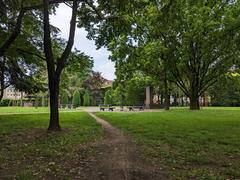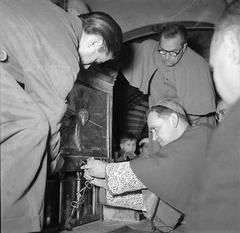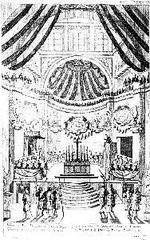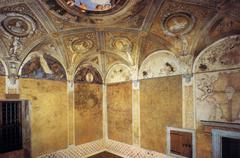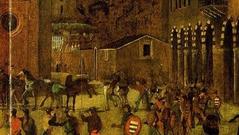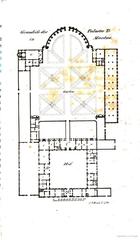Palazzo del Massaro Visiting Hours, Tickets, and Guide to Mantua Historical Sites
Date: 04/07/2025
Introduction: Discover Mantua’s Civic Jewel
Palazzo del Massaro, set in the heart of Mantua’s UNESCO-listed historic center, is a lesser-known yet captivating emblem of the city’s Renaissance heritage. Once the residence and office of the massaro—a civic official responsible for municipal finances—this palace offers visitors a unique window into Mantua’s administrative, social, and artistic history from the 14th to the 16th centuries. It stands apart from Mantua’s grand palaces by providing an intimate setting where civic legacy and artistic treasures converge. Today, Palazzo del Massaro continues to preserve its rich past, functioning both as a cultural venue and a dining destination, and is ideally situated for those wishing to explore Mantua’s vibrant urban fabric (Italy This Way; Mantova Notizie; UNESCO Mantua).
Table of Contents
- Introduction
- Historical Background
- Artistic and Architectural Highlights
- Visitor Guide
- Notable Features and Unique Aspects
- Frequently Asked Questions (FAQ)
- Practical Tips for Visitors
- Connections to Mantua’s Renaissance Heritage
- Summary and Visitor Recommendations
- References
Historical Background
Origins and Administrative Function
Palazzo del Massaro was constructed in the 14th century, a period when Mantua, under the Bonacolsi and early Gonzaga rule, was rapidly expanding its administrative and civic infrastructure. The term “massaro” denoted a key steward overseeing municipal assets and finances. The palace’s location, adjacent to other civic buildings in Piazza Broletto, underscores its central role in Mantua’s governance (Wikipedia; Spotting History).
Renaissance Evolution and the Gonzaga Connection
As Mantua flourished under the Gonzaga dynasty in the 15th and 16th centuries, the palace was adapted to reflect Renaissance ideals of symmetry and classical restraint. Notably, it served as the residence of Francesco Gonzaga after his elevation to cardinal, with frescoed evidence of this period still visible. Its architectural evolution was shaped to harmonize with neighboring palaces and squares, making it a vital piece of Mantua’s Renaissance ensemble (Garda Outdoors; Culture Activities).
Artistic and Architectural Highlights
Exterior and Urban Context
The palace’s façade, constructed with locally sourced brick, is characterized by balanced proportions and a prominent entrance portal. It aligns with the adjacent Palazzo della Dogana and is linked to the Palazzo del Podestà by the Arengario—a 14th-century arched passageway with alternating bands of white stone and red brick that creates architectural harmony within the square (Comune di Mantova; Mantova Notizie).
Interior Frescoes and Decorative Arts
Inside, Palazzo del Massaro houses remarkable 15th-century frescoes attributed to followers of Pisanello. These include the oldest known painted map of Mantua (c. 1433) and the Gonzaga family coat of arms—rare survivals that offer insight into Mantua’s medieval and Renaissance artistic culture (Mantova Notizie). The interiors also feature vaulted ceilings and decorative elements typical of Lombard Renaissance design.
Visitor Guide
Visiting Hours & Tickets
Palazzo del Massaro is not a conventional museum but can be visited during the hours of the onsite restaurant-pizzeria, “Masseria.” Standard hours are:
- Lunch: 12:00 PM – 2:30 PM
- Dinner: 7:00 PM – 10:30 PM
There is no separate ticket for entry; access to the frescoed halls is included with dining. Those wishing to view the frescoes without dining should contact the restaurant in advance to check availability (La Viaggiatrice Solitaria).
Accessibility and Amenities
The ground floor is generally accessible, but due to the building’s historic nature, some uneven surfaces may exist. Visitors with mobility needs should contact the restaurant ahead of time to arrange accommodations. The palace is located at Piazza Broletto 8, a short walk from key city attractions, and is easily reached via Park & Ride services with shuttle buses to the city center (Places of Juma).
Dining and Cultural Events
Dining at “Masseria” allows guests to experience traditional Mantuan cuisine—such as tortelli di zucca and stracotto—in a unique frescoed setting. The palace occasionally hosts cultural events and is a popular stop during city festivals, including the Mantova Summer Festival (ItalyScapes). Its proximity to the Virgil Museum and other landmarks makes it an ideal part of any Mantua itinerary (Finestre sull’Arte).
Notable Features and Unique Aspects
- 15th-century frescoes with the oldest painted map of Mantua and Gonzaga insignia.
- Adaptive reuse as a restaurant, preserving the building’s historic atmosphere.
- Central location in Mantua’s historic core, facilitating exploration of other Renaissance sites.
Frequently Asked Questions (FAQ)
Q: What are Palazzo del Massaro’s visiting hours?
A: The palace is accessible during restaurant hours: 12:00 PM–2:30 PM for lunch and 7:00 PM–10:30 PM for dinner. Check with the restaurant for updates.
Q: Is there a ticket fee?
A: No separate ticket is required; access is included with dining. Viewing frescoes without dining may require prior arrangement.
Q: Is the palace accessible for people with disabilities?
A: The ground floor is generally accessible; contact the restaurant for specific needs.
Q: Can I see the frescoes without dining?
A: Inquire with the restaurant ahead of time; access without dining is limited.
Q: How do I get there and where can I park?
A: Use Park & Ride parking outside the historic center and take the shuttle to Piazza Broletto.
Practical Tips for Visitors
- Reserve ahead: Book a table, especially on weekends or during festivals.
- Combine visits: Pair with nearby sites like Palazzo del Podestà and the Virgil Museum.
- Photography: Always ask before photographing the frescoes to respect preservation policies.
- Language: Some staff speak English, but basic Italian or a translation app is helpful.
Connections to Mantua’s Renaissance Heritage
Palazzo del Massaro is integral to understanding Mantua’s Renaissance urbanism and civic life. While not as grand as the Palazzo Ducale or opulent as the Palazzo Te, it played a key role in the city’s administration and continues to embody the intersection of governance, art, and daily life. Its strategic location puts visitors in close proximity to Mantua’s most important squares and monuments, making it an essential stop for those exploring the broader Renaissance story of the city (italien-entdecken.de; justinpluslauren.com).
Summary and Visitor Recommendations
Palazzo del Massaro bridges Mantua’s administrative past, artistic heritage, and contemporary culture. Its modest but elegant architecture, rare frescoes, and adaptive reuse as a dining venue make it a distinctive destination. Visitors enjoy easy access, inclusive amenities, and a central location ideal for exploring Mantua’s other Renaissance treasures. To enrich your experience, use guided audio tours via the Audiala app, plan visits to neighboring attractions, and check for special events or exhibitions (Italy This Way; Mantova Notizie; UNESCO Mantua).
References
- Italy This Way: Mantua
- Culture Activities: Things to Do in Mantua
- Mantova Notizie: Arengario & Palazzo del Massaro
- Italien Entdecken: Mantua
- UNESCO World Heritage Centre – Mantua
- Comune di Mantova: Palazzi Storici
- Wikipedia: Palazzo del Massaro
- Spotting History: Mantua
- Garda Outdoors: Exploring Palazzo Te
- Places of Juma: Mantua
- La Viaggiatrice Solitaria: Mantua
- Finestre sull’Arte: Virgil Museum
- ItalyScapes: Mantova Summer Festival
- justinpluslauren.com: Mantua
Enhance your visit by downloading the Audiala app for audio guides, maps, and up-to-date event information. Follow us on social media for the latest travel tips and news about Mantua’s cultural sites.

